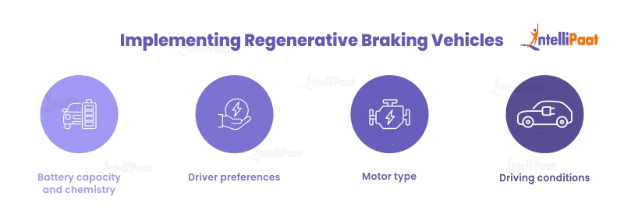Regenerative Braking in Electric Vehicles
This blog will go over the concept of regenerative braking in electric vehicles in full detail, including such topics as how regenerative braking works, the benefits of regenerative braking, and how regenerative braking might be used to further improve the efficiency and sustainability of EVs. Whether you are a seasoned EV enthusiast or a curious newcomer, let’s get ready for an electrifying ride!
Learn everything you need to know to begin your path to becoming an ACE by watching this informative YouTube video on the beginner’s guide to Electric Vehicles.
{
“@context”: “https://schema.org”,
“@type”: “VideoObject”,
“name”: “Beginner’s Guide to Electric Vehicles | Types of EV | Future of EV | Intellipaat”,
“description”: “Regenerative Braking in Electric Vehicles”,
“thumbnailUrl”: “https://img.youtube.com/vi/2F1l4H53fRk/hqdefault.jpg”,
“uploadDate”: “2023-05-16T08:00:00+08:00”,
“publisher”: {
“@type”: “Organization”,
“name”: “Intellipaat Software Solutions Pvt Ltd”,
“logo”: {
“@type”: “ImageObject”,
“url”: “https://intellipaat.com/blog/wp-content/themes/intellipaat-blog-new/images/logo.png”,
“width”: 124,
“height”: 43
}
},
“contentUrl”: “https://www.youtube.com/watch?v=2F1l4H53fRk”,
“embedUrl”: “https://www.youtube.com/embed/2F1l4H53fRk”
}
Table of content
- Introduction to Regenerative Braking
- How Regenerative Braking Works
- Benefits of Regenerative Braking
- Regenerative Braking System Project: A Closer Look
- Regenerative Braking of DC Motor: The Technical Side
- Implementing Regenerative Braking in Electric Vehicles
- Regenerative Braking System in Electric Vehicles: The Future
- Conclusion
Introduction to Regenerative Braking
Regenerative braking is a term that is frequently used when talking about electric cars (EVs), but what does it actually mean? Regenerative braking is a technique that’s commonly used in electric and hybrid vehicles to recover energy that would normally go to waste while braking.
When a vehicle with a regenerative braking system follows a braking system, some of the energy that would often be lost as heat through the brakes is instantly captured by the electric motor or generator on the wheels of the vehicle. This energy is then stored in the vehicle’s battery for later use instead of being wasted as heat.
Regenerative braking enables electric and hybrid vehicles to recapture some volume of the lost energy during braking. This can increase their overall efficiency. Regenerative braking is an essential technology for advancing environmentally friendly transportation in the future because it can lead to energy-efficient long drivable distances.
How Regenerative Braking Works

By transforming the kinetic energy of a moving vehicle into electrical energy, regenerative braking works. In a car with regenerative braking, the electric motor or the generator on the wheels is activated, and the vehicle begins to slow down.
As the wheels slow down, the electric motor or generator converts the vehicle’s kinetic energy into electrical energy, which is then stored in the battery. Regenerative braking is the term for this process in electric or hybrid cars that transforms kinetic energy into electrical energy.
The quantity of energy that can be recovered through regenerative braking depends on several variables, such as the vehicle’s weight, speed, and the effectiveness of the regenerative braking system.
Regenerative braking is used in some cars to slow the vehicle down to a complete stop, while in others it just helps to assist the conventional friction brakes. To increase their overall efficiency and lower environmental impact, regenerative braking has become a vital component of electric and hybrid vehicles.
Want to master electric vehicles? This electric vehicle course is designed for you if you want to learn everything there is to know about them.
Benefits of Regenerative Braking

Regenerative Braking offers multiple benefits, which will be discussed in detail in the points mentioned below.
Regenerative braking systems offer a myriad of advantages, including
- Eco-friendliness – Regenerative braking may reduce the carbon footprint of electric and hybrid vehicles by lowering the amount of energy required to power the vehicle, which leads to fewer greenhouse gas emissions and a decreased reliance on fossil fuels.
- Increased Energy Efficiency – Regenerative braking systems smoothly increase the driving range of electric cars by collecting the kinetic energy that is generally wasted while braking. This implies that one charge will allow you to travel further!
- Reduced Brake Wear – The requirement for conventional friction brakes is reduced because the electric motor performs most of the braking. As a result, you’ll spend less on maintenance because your brake pads and rotors will last longer.
Regenerative Braking System Project: A Closer Look
A typical regenerative braking system project consists of several key components, including
- Electric motor/ generator – This part offers two purposes: it powers the car and produces electricity during regenerative braking.
- Controller – The controller manages the energy transfer between the battery and the generator/motor.
- Brake pedal sensor – This sensor recognizes when you push the brake pedal and alerts the controller to activate the regenerative braking system.
- Battery – The battery stores energy generated during regenerative braking for future use.
Together, these elements provide an effective and environmentally sustainable braking system for electric cars.
Explore Electric Vehicle Career Opportunities to Join the Revolution!
Regenerative Braking of DC Motor: The Technical Side
EVs use a variety of electric motor types but for the purposes of this discussion, let’s prioritize the regenerative brakes of DC motors. Although they are an older technology, direct current (DC) motors still have a place in some electric cars.
The DC motor works as a generator when the car brakes, generating a voltage that is the opposite of the motor’s rotational direction. The motor slows down as a result of this “counter electromotive force” (CEMF) action, which also produces electrical energy. The battery is where the energy is then transferred and stored for later use.
Controlling the CEMF is essential for effective regenerative braking in a DC motor. In order to maximize the energy recovered during braking, a mixture of sensors, controls, and power electronics is often used.
If you want to learn more about electric vehicles, read our blog, What is an EV?
Implementing Regenerative Braking in Vehicles

It is important to carefully evaluate the vehicle’s entire design and powertrain when integrating a regenerative braking system in electric vehicles. Regenerative braking systems are often tuned by manufacturers to create a balance between energy recovery and a comfortable, smooth ride.
When using regenerative braking in electric vehicles, bear the following in mind
- Battery capacity and chemistry – The amount of energy that can be stored during regenerative braking can depend on the battery’s chemistry and capacity.
- Driver preferences – While some drivers like a more powerful form of regenerative braking, others favor a softer, more conventional braking experience. To meet these needs, manufacturers frequently include changeable settings.
- Motor type – Different electric motor types (such as DC, AC induction, or permanent magnet) have various properties that can impact how well a regenerative braking system works.
- Driving conditions – Regenerative braking systems should be designed according to the kind of driving, such as off-roading, highway driving, or city driving.
Regenerative Braking System in Electric Vehicles: The Future
Regenerative braking systems in electric vehicles will probably become even more efficient and user-friendly as EV technology advances. Expect improvements in energy recovery and driving range as a result of developments in motor design, battery science, and control systems.
Additionally, the advantages of regenerative braking will become more evident as the adoption of electric vehicles picks up speed around the world. Regenerative braking systems will be essential for enhancing the sustainability and environmental friendliness of our transport systems.
Conclusion
Regenerative braking is a cutting-edge innovation that is now an important part of the electric vehicle market. It has the potential to significantly increase the effectiveness and range of electric vehicles by recovering energy that is generally lost during braking and using that to recharge the battery. Additionally, this technology may reduce the degradation of conventional friction brakes, which will result in lower maintenance costs for owners of electric vehicles. Regenerative braking technologies are likely to progress and become more prevalent as the demand for electric vehicles rises.
So keep in mind that every time you press the brake pedal while operating an electric vehicle, you’re not only slowing down; you’re also helping to create a more sustainable and cleaner future for our planet.
Join the Intellipaat community to ask questions and leave comments.
The post Regenerative Braking in Electric Vehicles appeared first on Intellipaat Blog.
Blog: Intellipaat - Blog
Leave a Comment
You must be logged in to post a comment.








